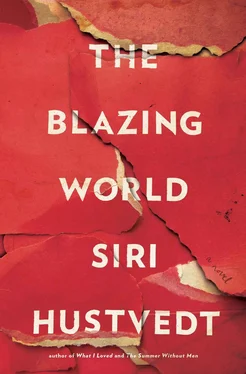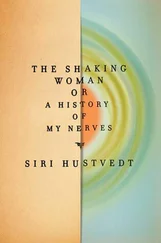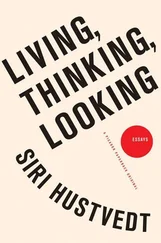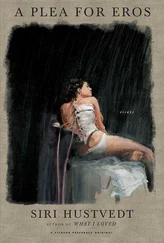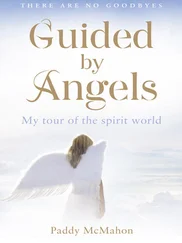Exactly when our project was hatched I can’t remember, but one Saturday I visited Harry’s studio and noticed she had painted SUFFOCATION in huge letters on the wall. “I’m thinking about it,” she said, “as a theme.” Then she changed the subject, or so I thought at the time. I now believe it was the same subject, not a transition, because it was a story about her father. She told me about her first show in New York, when she was in her early thirties. Her parents came to the opening. Her mother was sweet and proud and full of congratulations. Her father was silent, but then right before he left, he said to her, “It doesn’t resemble much else that’s out there, does it?”
I asked her what he had meant. She said she didn’t really know. I asked her how she answered back, and she said, “I didn’t say anything.”
He shut her up.
The man wasn’t some unsophisticated boob; he knew art. He had a hankering for Frank Stella, she told me. I said to Harry: “That’s pretty cold, don’t you think? I mean, it’s a cold thing to say to your own daughter.”
“That’s what Doctor F. says.”
I told her a medical degree wasn’t needed to see cold as cold.
Harry looked as if she might cry.
I pretended to be sorry, but I wasn’t.
Harry told me lots of stories about the man, and my opinion on the matter is that her dad, when he was among the living, had a problem with both who Harry was and with what she did. Being and Doing — the big ones. Harry’s work was warm: I don’t mean electrically heated — I mean it was passionate and sexed-up and scary. Her father was a tight-ass who liked neat, closed systems: the world in a jar. What was he going to make of her stuff? He wouldn’t have liked it whoever had done it. Still, I didn’t blame Harry for trying. Hadn’t I spent my whole goddamned life making up stories about my own heroic father, loving and hating him? And when Daryl came along courting Mama with his big smiles and his shiny shoes, hadn’t I wished he would just vanish or drop dead on the spot?
We started our collaboration because Harry wanted a phallic front. I told her she should think twice about taking on a swishy black man, but Harry was undeterred by my status as a member of not one but two minorities. She wanted scenes of suffocation, she said, metaphorical ones, not pillows over a face, but a theater of rooms the spectator had to enter, and she wanted me to help her build it. Hadn’t I lived my life mostly as a nancy boy? Hadn’t I changed my name in 1995 to celebrate my second self? Hadn’t I known what it felt like to be smothered before that, Pentecostal tongues or no tongues? Didn’t we live in a country that is perverted by racism? Wasn’t I a black man, even though I wasn’t much darker than Harry? People still called me “black,” didn’t they? What did skin tone have to do with it? Her mother was Jewish, so she was Jewish. She knew something about anti-Semitism. The Protestant set of her grandparents had been sick with that particular strain of flu. And what about sexism? How many years had women had the vote? Not even a hundred years! Didn’t I play a man and a woman, a white man and a black woman in one body? (Harry swooned for Hester and Lester, especially Hester, the whinnying, haranguing spouse of the not-nearly-so-gabby Lester.) Didn’t we understand each other? Weren’t we alike in many ways? (Harry’s identification with me might sound outrageous to some people, but it was sincere.) She didn’t truck much with conventional ways of dividing up the world — black/white, male/female, gay/straight, abnormal/normal — none of these boundaries convinced her. These were impositions, defining categories that failed to recognize the muddle that is us, us human beings. “Reductionism!” She used to shout this every now and then. Her son took after her. Neither of them liked what they saw out there in the big world — received ideas were for peons and huckleberries — and yet, there was tension between them— bristling is the word. Maisie was the peacemaker, the sweetie pie waving a white flag.
Back to The Suffocation Rooms : I’m proud of what I gave them, my own twists and turns, but it was Harry’s work. It was her idea that the viewer should shrink each time he or she opened a door and entered a new room. The rooms were nearly identical, the same grim-looking table and two chairs with vinyl seats, the same breakfast dishes laid out on the table, the same wallpaper made of Harry’s and my own handwriting and some doodles (I had free rein here to put in all my secret messages), and the same two metamorphs in each room. At the beginning of the journey, the furniture fit your median-size adult — we decided on five-seven — but with each consecutive room, the table and chairs, the cups and plates and bowls and spoons, the writing on the wallpaper grew that much larger, so that by the time you hit the seventh room, the scale of the furniture had turned you into a toddler. The soft, stuffed metamorphs grew, too, and they got progressively hotter. The seventh room felt like a Finnish sauna. After a discussion we decided that the single divided window in every room should be a mirror — more claustrophobic that way.
And then there was “the box.” Unlike all the other objects in the rooms, the box did not grow; it stayed the same size. Harry found a beaten-up wooden trunk with a lid and a lock and had six more made for her by some fabricator in Brooklyn. She was finicky as hell about it and sent one of them back five times before she was satisfied with the “distressing.”
I was the bright boy behind the color changes. I thought each room’s palette and its two characters should get a bit darker — moving from creamy white to a dusky caramel. And we decided to age the rooms. Each one should look a little older and worn than the one before, with furniture a bit more dilapidated, so we orchestrated stains, and scratched and ripped the wallpaper until by the last room you find yourself in a soiled, dingy, fraying kitchen parlor. Time had to get to the creatures, too, so Harry wrinkled up their foreheads, sagged their jaws, and pinched their necks.
We had a high time as wrecking crew. I recall the routine with affection. “Hand me the knife, P., old pal,” she would say. I would bow to her politely and produce the weapon. She would bow back to me and then impale the vinyl seat of one of the big chairs. I would congratulate her, “Well done, H., my buddy bud.” And she would say, “Your turn. A touch of dirt, P., chum of mine, should do the trick.” And I’d smear a wall or table with some mud we had prepared. Harry and I were co-stars in our own early talkie, a comedy team, P. and H. We had fun with pH, the sign of our togetherness and camaraderie.
pH: measure of acidity or alkalinity of a solution. We liked to say we leaned toward the acid. pH = —log [H+]: the logarithmic measure of hydrogen ion concentration as defined by the Danish biochemist Søren Sørensen. Many log jokes flew, including that it was short for what we produced: logorreah. We were the two halves of the Ph in PhD: philosophiae and D as in Daddy , and as in dead . We made up other initialisms on the spot: prurient hiccoughs —let your imagination run wild— peeping harlot, potted harridan, puckish hard-on, peevish huckster , et cetera, et cetera, et cetera. Sometimes we worked in costume, as two men, as two women, as a man and a woman, or reversed. The fat poet took a picture of the two of us in drag, but I don’t think he liked it. He liked his lady friend as his lady friend. Bruno has a macho streak. Nevertheless, Harry and I made the perfect drag couple. Big Harry and little ol’ me.
One day, while we were working on the rooms, she put down the screwdriver she was holding and looked at me with her serious face. “You know, P., my dear,” she said, “I like playing with you. I feel as if I’ve found the real playmate I wanted all those years ago when I was a kid, not imaginary, but real. I didn’t really have anybody until Rachel came along. You’re like the friend I dreamed of back then come to life.”
Читать дальше
